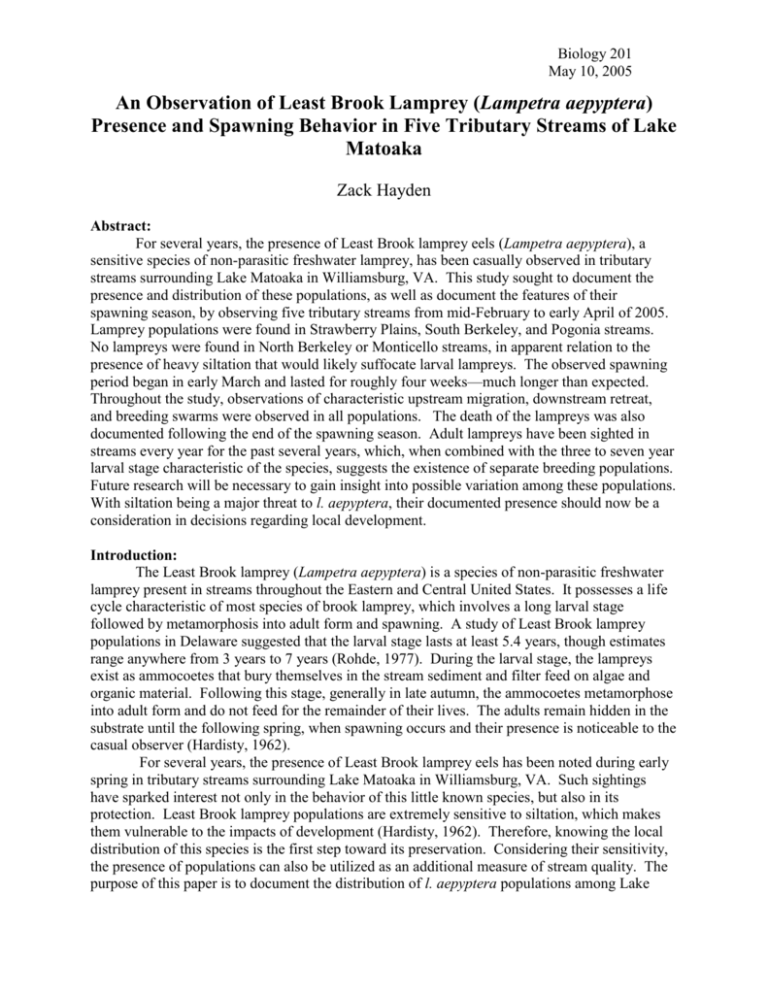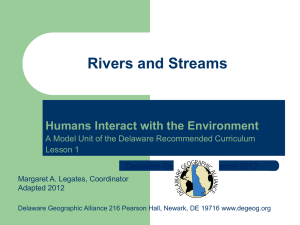An Observation of Least Brook Lamprey (Lampetra aepyptera
advertisement

Biology 201 May 10, 2005 An Observation of Least Brook Lamprey (Lampetra aepyptera) Presence and Spawning Behavior in Five Tributary Streams of Lake Matoaka Zack Hayden Abstract: For several years, the presence of Least Brook lamprey eels (Lampetra aepyptera), a sensitive species of non-parasitic freshwater lamprey, has been casually observed in tributary streams surrounding Lake Matoaka in Williamsburg, VA. This study sought to document the presence and distribution of these populations, as well as document the features of their spawning season, by observing five tributary streams from mid-February to early April of 2005. Lamprey populations were found in Strawberry Plains, South Berkeley, and Pogonia streams. No lampreys were found in North Berkeley or Monticello streams, in apparent relation to the presence of heavy siltation that would likely suffocate larval lampreys. The observed spawning period began in early March and lasted for roughly four weeks—much longer than expected. Throughout the study, observations of characteristic upstream migration, downstream retreat, and breeding swarms were observed in all populations. The death of the lampreys was also documented following the end of the spawning season. Adult lampreys have been sighted in streams every year for the past several years, which, when combined with the three to seven year larval stage characteristic of the species, suggests the existence of separate breeding populations. Future research will be necessary to gain insight into possible variation among these populations. With siltation being a major threat to l. aepyptera, their documented presence should now be a consideration in decisions regarding local development. Introduction: The Least Brook lamprey (Lampetra aepyptera) is a species of non-parasitic freshwater lamprey present in streams throughout the Eastern and Central United States. It possesses a life cycle characteristic of most species of brook lamprey, which involves a long larval stage followed by metamorphosis into adult form and spawning. A study of Least Brook lamprey populations in Delaware suggested that the larval stage lasts at least 5.4 years, though estimates range anywhere from 3 years to 7 years (Rohde, 1977). During the larval stage, the lampreys exist as ammocoetes that bury themselves in the stream sediment and filter feed on algae and organic material. Following this stage, generally in late autumn, the ammocoetes metamorphose into adult form and do not feed for the remainder of their lives. The adults remain hidden in the substrate until the following spring, when spawning occurs and their presence is noticeable to the casual observer (Hardisty, 1962). For several years, the presence of Least Brook lamprey eels has been noted during early spring in tributary streams surrounding Lake Matoaka in Williamsburg, VA. Such sightings have sparked interest not only in the behavior of this little known species, but also in its protection. Least Brook lamprey populations are extremely sensitive to siltation, which makes them vulnerable to the impacts of development (Hardisty, 1962). Therefore, knowing the local distribution of this species is the first step toward its preservation. Considering their sensitivity, the presence of populations can also be utilized as an additional measure of stream quality. The purpose of this paper is to document the distribution of l. aepyptera populations among Lake Biology 201 May 10, 2005 Matoaka tributary streams, and to provide a description of their observed behavior during the spawning period. Very few studies have been focused specifically on l. aepyptera, and therefore the unique opportunity exists to compare observations of this species with the available literature on brook lampreys in general. Methods: For the study, five tributary streams of Lake Matoaka were observed from February 15, 2005 to April 5, 2005. Working around class schedules, surveys of Strawberry Plains, Pogonia, South Berkeley, North Berkeley, and Monticello streams were carried out repeatedly, generally between late morning and early afternoon. A summary of all surveys is available in spreadsheet form. Qualitative observations of stream siltation and previous water quality measurements for each stream from Ludlow and Wygant (2002) were compared to the observed distribution of l. aepyptera. In streams where populations were present, the spawning stage, from onset to decline, was observed and documented using digital photography, and a library of all videos and photographs from the study was compiled for later reference. Observing the behavior of the adult lampreys during migration and spawning was a key objective. Results: Populations were only observed in Strawberry Plains, South Berkeley, and Pogonia. These streams also generally had the most favorable water quality, and low observed levels of siltation. In contrast, lampreys were never observed in North Berkeley or Monticello, and both streams display significant siltation in comparison to the others. Non-observance does not eliminate the possibility that populations exist in these streams, but when correlated with presumably poor habitat quality, it makes absence likely. Due to time constraints, observations of North Berkeley and Monticello were suspended in the latter parts of the study, and the remaining three streams received increased focus. The spawning season, and thus the appearance of the adult lampreys, is expected to begin between March and April (Hardisty, 1962). This generalization was supported by all three populated streams. Lampreys were observed in Strawberry Plains and South Berkeley first, on March 1 and March 2, respectively. Lampreys in Pogonia were observed later on March 4, but densities larger than 1 or 2 individuals were not observed until March 14. These onsets correspond to previously documented sightings, where lampreys were found on March 12, 2002 in Pogonia (Spiller, 2002) and on March 3, 2004 in Strawberry Plains (Schobel, 2004). Such documentation, though limited in scope, may suggest recent consistency in the appearance of the spawning season from year to year. The spawning period for each population observed in this study declined at about the same time, and observed densities in all streams were below three living individuals by April 5. The duration of the spawning period in all streams is notable. Whereas the spawning season of the typical brook lamprey generally lasts for one to two weeks, the observed populations spawned for roughly four weeks—much longer than expected. It has been suggested that the duration of the spawning season is related to both the local weather conditions and the size of the spawning population, with low and fluctuating temperatures and larger populations favoring a longer season (Hardisty, 1962). Therefore, the observed spawning period may have been influenced by such factors. However, water temperature measurements were not taken and no focused efforts at population size estimates were made, so all mention is purely speculation. Nevertheless, the largest observed densities in a single survey on Strawberry Plains, South Berkeley, and Pogonia were 30, 22, and 24 Biology 201 May 10, 2005 individuals, respectively. Such observations do suggest similar population sizes in all streams, which in theory could contribute to the roughly conserved duration of the spawning season. The first task for populations of brook lampreys during the spawning stage is to get to suitable spawning sites. Downstream drift is likely during the ammocoete stage, so adults must migrate upstream to return to the suitable spawning areas (Hardisty, 1962). This general upstream movement was first noticed in all observed l. aepyptera populations during the early stages of the study. From survey to survey on each stream, lampreys tended to be sighted upstream from where individuals were sighted previously. As the study progressed, many direct examples of upstream movement of lampreys were observed and documented, supporting the concept of upstream migration to spawning areas. The movement of individual lampreys upstream was fascinating in itself. The lampreys would progress efficiently against the current for a certain interval, but then rest for some time by attaching themselves to a rock or catching themselves in debris before eventually repeating the process. They would proceed upstream, and even over significant obstacles, only in this stop and go fashion. Several lampreys were observed on different occasions actually pushing themselves over small logs and other apparently impassable stream-spanning obstructions. Such upstream feats were accomplished via rapid wriggling movements between periods of rest. Interestingly enough, similar mechanics of migration are observed in anadromous species of lamprey that may migrate for hundreds of miles (Hardisty, 1962). The strength with which l. aepyptera was able to pass over upstream obstacles demonstrates that reasonable obstructions do not necessarily pose a barrier to migration. However, certain obstacles still seem impassable. For example, at one point Strawberry Plains is interrupted by a twenty-foot dry bed; no lampreys were sighted above that point. Finding lampreys above and below any such obstruction could possibly denote the presence of two separate populations in the same stream—an interesting situation. However, no such observations were made during this study. In addition to upstream movement, a characteristic “downstream retreat” was observed in response to disturbance. If a lamprey was touched or grasped, it would immediately begin writhing, thrust itself into the current, and fall swiftly downstream. This interesting mechanism was documented in all three populations and in many different individuals. Presumably, swimming with the current allows for the quickest escape and the best chance of survival. Individuals tended to fall downstream just far enough until they could grasp and hide themselves in debris or substrate, thus keeping the spawning areas within reach. Among typical brook lamprey species, upstream migration culminates in the location of suitable spawning sites, which are generally characterized by moderate stream surface velocities and a substrate composed of gravel and sand. Lampreys then congregate at these sites and interact typically in groups of 10 to 30, writhing around each other in motions that excavate a slight depression in the substrate that will serve as the nest, where eggs will be laid (Hardisty, 1962). Such characteristic “breeding swarms” were the most notable feature of the observed l. aepyptera populations. In all streams, the swarms tended to occur over gravelly and sandy substrates and in areas where the lampreys were sheltered from the current—such as in riffles behind debris or obstructions. Furthermore, swarms generally consisted of between 5 and 20 individuals, though notable differences in size existed between streams. Swarms of more than about 8 individuals were not observed in either South Berkeley or Pogonia, and the location of swarms in these streams was highly variable from survey to survey. Biology 201 May 10, 2005 In contrast, the swarms observed in Strawberry Plains were consistently larger, occasionally involving as many as 20 or more individuals, and the swarms were localized in a specific area of the stream. The most populated site was characterized by a pile of debris on one side of the stream bank that projected out into the current, creating a stretch of calmer water above a sand and gravel substrate. Individuals would be seen interacting in the open above the substrate, and also coming and going from beneath the debris, which created a sort of shelter. All swarms on Strawberry were observed at this site and at similar sites within a range of about 20 feet upstream or downstream of it. These observations at first suggested the possibility that l. aepyptera migrated to specific pre-determined spawning sites; however, such a theory was not supported by observations in the other streams, whose populations were dispersed in small, variable breeding swarms rather than congregated in one area. It will be interesting to see whether the spawning sites on Strawberry Plains are conserved from year to year, and thus among different populations. It has been suggested that such return behavior is related simply to the characteristics of the stream at that point (Hardisty, 1962), and this is most likely the case with the localization on Strawberry. The observed spawning sites were seemingly ideal in many respects, and concentration of the l. aepyptera population may occur there simply for that reason. The first signs of the decline of the spawning season came on March 29, with the observation of one dying and one dead lamprey on Strawberry Plains. The remains of two dead lampreys were found on South Berkeley on April 1, and as previously noted, observed densities in all streams were below three individuals by April 5. These were the only remains of dead lampreys found during the conclusion of the spawning season, which was characterized more by a gradual decline in observed live densities than by overt signs of death. However, this is not surprising considering the constant alluvial deposition in the streams, which would quickly bury the already camouflaged bodies of any dead lampreys in the sediment. The dying lamprey found in Strawberry Plains presented a unique opportunity to document the end of the l. aepyptera life cycle, which appeared to proceed gradually. The observed lamprey was alive, though sedentary, and only sluggishly responsive to prodding. Several other lampreys observed during this time period were also notably sluggish, suggesting that the death of individual lampreys consists of a decline over an extended period of time that ultimately results in the loss of body function. Furthermore, individuals must undergo this process at varying intervals in order to provide for the gradually declining active populations that were observed during the last week of the study. Conclusion: The documentation of l. aepyptera populations in Strawberry Plains, South Berkeley, and Pogonia during this study establishes the existence of populations in these streams. Furthermore, documented and unofficial accounts of sightings exist in one or more of these streams every year since 2001 (Schobel, 2004). Due to the 3 to 7 year larval stage of Least Brook lampreys, the appearance of adults every year is irrefutable evidence for the presence of several separate breeding populations in each stream. This study only observed the spawning season and behavior of one population. Thus, continued observation in subsequent years could lead to greater insight into the variability between populations, and also into the possible conservation of swarming sites among different non-interacting populations. The lack of observed lampreys in North Berkeley and Monticello, combined with the heavy siltation characteristic of those streams, makes the presence of populations there highly unlikely. However, observation in subsequent years will be necessary to confirm with greater Biology 201 May 10, 2005 confidence that no populations exist. The poor quality of both streams is likely to be related to the presence of development toward their headwaters. If conditions ever changed, the quality of these streams could improve, and in that case, reintroduction of l. aepyptera may be an option for future researchers to consider. However, preservation should be the greatest concern now. With the documented presence of l. aepyptera populations in three tributary streams of Lake Matoaka, the threat to this sensitive species should be an added consideration in decisions regarding local development. References Hardisty, M.W. & Potter, I.C. (eds.) (1971). The Biology of Lampreys. Vol I. Academic Press, London. pp 127-206. Ludlow, Bonnie and Tim Wygant. (2002). Water Quality of Lake Matoaka and its Tributary Streams. Keck Environmental Field Lab. 4 May 2005. <http://www.wm.edu/environment/ Research/02i.html>. Rohde, FC; Arndt, RG; Wang, JCS. (1975). Records of the freshwater lampreys, Lampetra lamottenii and Okkelbergia aepyptera, from the Delmarva Peninsula (East Coast, United States). Chesapeake Sci. Vol. 16, no. 1, pp. 70-72. Schobel, Michael J. “Rare Fish Found in Campus Woods.” The Flat Hat Online Edition. 2 Apr. 2004. 7 May 2005. < http://flathat.wm.edu/2004-04-02/story.php?type=1&aid=3>. Spiller, Adam and Morgan Sproul. (2002). A Chemical and Fish Survey of Streams in the College Woods. Keck Environmental Field Laboratory. 4 May 2005. < http://www.wm.edu/ environment/Research/02b.html>.









